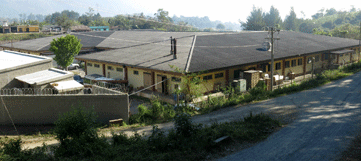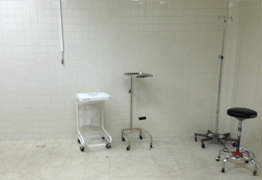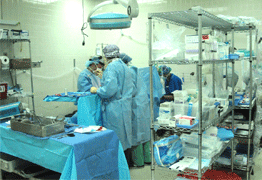
AMN Mission to Guatemala: Building a Hospital in One Afternoon
SAN CRISTOBAL ALTA VERA PAZ, GUATEMALA – How do you create a near-complete health system in a few hours? HELPS International accomplished this feat last Sunday afternoon with the help of AMN Healthcare in the highlands of Guatemala. In fact, HELPS undertakes this arduous task several times a year at different locations in this lush green but impoverished land. What’s required are a team of dedicated volunteers, a few staff members who work really hard, steadfast donors and great logistics. And an empty hospital.
In Guatemala, a dozen small hospitals were built with international aid in the 1970s, but today they stand mostly empty due to a lack of funding and clinicians. These hospitals provide very limited health services, but with little equipment, supplies and drugs and no surgeons. For one-week periods, HELPS takes over these hospitals and creates operating suites, pre-op facilities, a post-anesthesia care unit (PACU), an inpatient room for overnight stays, a pharmacy, medical clinics, a dentistry clinic, a patient scheduling system, a medical records systems, a lab and a cafeteria.
 Logistics are critical. Exact inventories are kept of equipment and supplies left at the hospitals from the last mission or stored in the HELPS warehouse in Guatemala City, and then matched against needs for the new medical mission. HELPS logistics staff in Dallas and Guatemala city then complete the laborious task of obtaining supplies from donors and by purchase in both the US and Guatemala, and moving them to the hospital.
Logistics are critical. Exact inventories are kept of equipment and supplies left at the hospitals from the last mission or stored in the HELPS warehouse in Guatemala City, and then matched against needs for the new medical mission. HELPS logistics staff in Dallas and Guatemala city then complete the laborious task of obtaining supplies from donors and by purchase in both the US and Guatemala, and moving them to the hospital.
Each volunteer making his or her way from the United States brings one large bag of supplies and pharmaceuticals as luggage to Guatemala. But not before a HELPS staff member in Dallas arranges all documentation for the US Drug Enforcement Administration to take narcotics out of the country and for exporting all supplies and equipment. Transportation and documentation for each volunteer also must be arranged. On the Guatemala side, purchases and transportation must be arranged so that everything arrives at the hospital at the same time.
A meticulous medical records system is re-created on the spot. HELPS has patients whose medical records date back ten years, and both HELPS and the patients keep copies of the records. For many people in the highlands, their doctor is a HELPS doctor, and HELPS maintains their charts. A portable electronic medical records system hasn’t been acquired yet, but HELPS medical staff are hopeful.
In addition to doctors and nurses, translators are critically important for every unit, to make sure patients understand doctor’s orders and pharmacy prescriptions, and to ensure that patient interviews and medical records  are exact. HELPS brings a team of students from Guatemala City who are fluent in English and Spanish. But that’s not enough, because many people of the highlands are indigenous and speak only Kek'chi, Pokom’chi and A'chi. HELPS has a staff interpreter who understands indigenous languages, and who also does public health work in the community. But she doesn’t speak English, so clinicians may need two interpreters to communicate with patients.
are exact. HELPS brings a team of students from Guatemala City who are fluent in English and Spanish. But that’s not enough, because many people of the highlands are indigenous and speak only Kek'chi, Pokom’chi and A'chi. HELPS has a staff interpreter who understands indigenous languages, and who also does public health work in the community. But she doesn’t speak English, so clinicians may need two interpreters to communicate with patients.
>Before the volunteers arrive, water (which is scarce) is delivered and the hospital cleaned. On Sunday afternoon, the volunteer doctors, nurses and allied professionals make the six-hour bus ride into the mountains on roads that begin as a highway and end as a narrow unpaved byway. Upon arrival, the first thing they see is a line of hundreds of people waiting for care. The crowd of prospective patients and their families bursts into applause and waves to the volunteers in buses.
That’s impetus enough for the nurses, doctors and other volunteers to jump to work inventorying supplies and equipment, hauling large bins of supplies and equipment stored from the last mission and unpacking them in the empty operating theater. Immediately, from the bare, echoing rooms, the inside of a hospital takes shape. By evening, the first 50 patients come through the doors and visit the clinic or are scheduled for surgery and dentistry beginning the next morning.
From almost nothing, a health system arises that will save lives and reduce pain and disability for more than a thousand people in the next six days.


